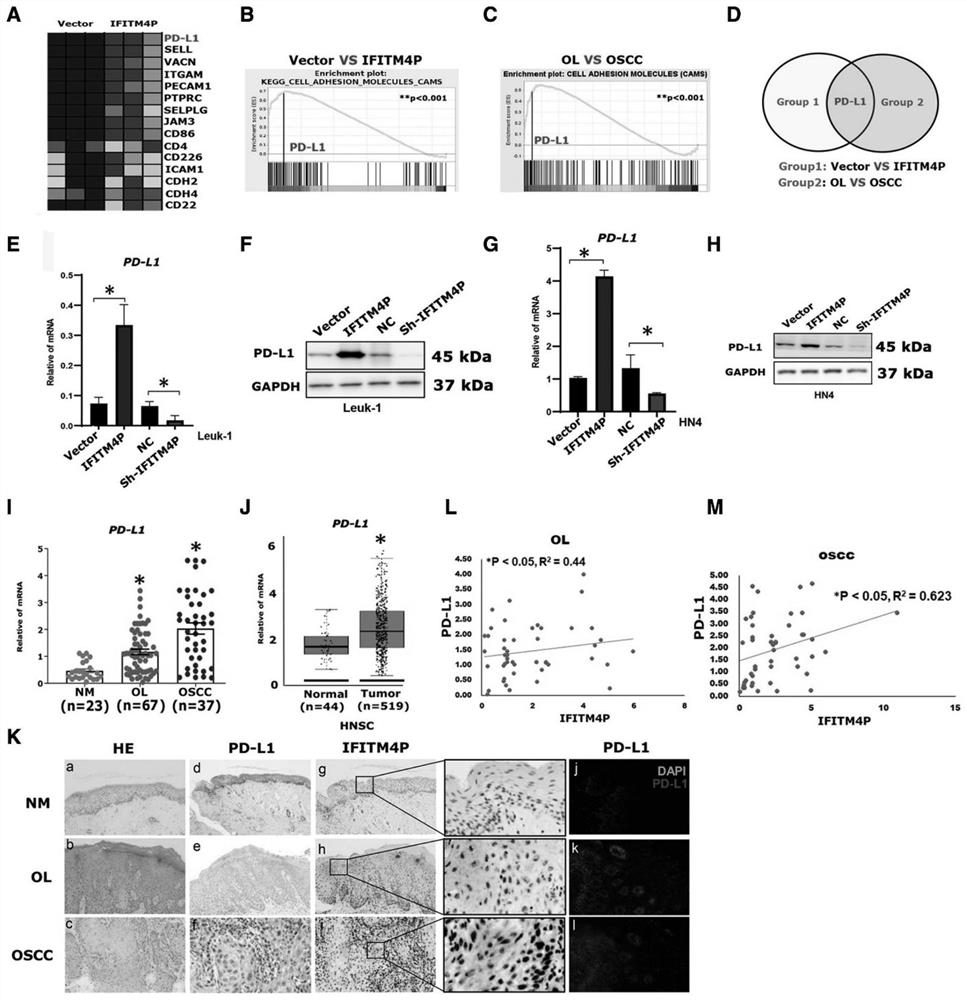Application of LncRNA IFITM4P as molecular marker in oral leukoplakia and/or oral cancer
A technology of molecular markers and oral leukoplakia, applied in the field of biomedical detection, can solve the problems of oral leukoplakia recurrence, multiple cancers, multiple occurrences, etc., and achieve the effect of improving low sensitivity
- Summary
- Abstract
- Description
- Claims
- Application Information
AI Technical Summary
Problems solved by technology
Method used
Image
Examples
Embodiment 1
[0091] RNA extraction and RT-PCR
[0092] (1) RNA extraction steps
[0093] a) When extracting tissue RNA, use 1 ml of Trizol reagent per 50-100 mg of tissue to dissolve the tissue, add 2-3 iron beads to the 1.5 ml EP tube added to the tissue, and use a cryogenic freezer automatic grinder to break the tissue; extract cells For RNA, centrifuge the cells at 800 g for 5 min, add 1 ml of Trizol to every 5 to 106 cells, and mix with a 1 ml pipette to lyse the cells.
[0094] b) The above-mentioned Trizol lysis solution of the tissue or cells was placed at room temperature for 5 minutes to fully lyse the tissue and cells.
[0095] c) In the above EP tube, add chloroform (trichloromethane) in an amount of 0.2 ml per 1 ml of Trizol, cover the EP tube, shake it on a vortex shaker for 15 seconds, and place it at room temperature (about 22°C). After 3 minutes, centrifuge at 12000g for 15 minutes at 4°C to separate the organic phase and the RNA-containing aqueous phase.
[0096] d) Tra...
Embodiment 2
[0127] To identify differentially expressed lncRNAs in oral normal mucosa (NM), OL and OSCC, in this example NM (n=3), OL (n=4) and OSCC (n=5) samples from Chinese patients were subjected to microarray analysis. array analysis, such as figure 1 A and Table 1.
[0128] The analysis revealed 3109 interactions between lncRNAs and mRNA transcripts in the NM, OL and OSCC groups (p2); focusing on 10 differentially expressed lncRNAs (5 genes were up-regulated, 5 genes were down-regulated), the difference fold>2, ***pfigure 1 C). The expression of IFITM4P was highest in OSCC / OL and OL / NM groups. To validate these observations, qRT-PCR was used to detect the expression of IFITM4P in samples of oral normal mucosa (NM) (n=23), OL (n=64) and OSCC (n=43), respectively, in contrast to OL and NM ratio, IFITM4P has the highest expression in OCSS and the lowest expression in NM ( figure 1 D), These results were validated by RNA fluorescence in situ hybridization (FISH) staining of samples ...
Embodiment 3
[0133] To determine the role of IFITM4P in oral carcinogenesis, Leuk-1 (OL) and HN4 (OSCC) cells were selected for this experiment, and were manipulated by stably transducing Leuk-1 cells with a lentiviral vector carrying a cDNA encoding the full length of IFITM4P Expression of IFITM4P ( figure 2 A), and analyzed cell growth and colony formation in these cells. The results showed that exogenous IFITM4P increased cell growth and colony formation in Leuk-1 cells ( figure 2 B, 2D and 2E).
[0134] In order to verify the opposite results, the present invention depleted IFITM4P in Leuk-1 cells by using IFITM4P-specific short hairpin RNA (shRNA) ( figure 2 A), and observed a significant reduction in cell growth and colony formation ( figure 2 B, 2D and 2E). Similar results were observed in the high expression of IFITM4P ( figure 2 F, 2G, 2I, and 2J) and deletions ( figure 2 F, 2H, 2I and 2J) were also seen in HN4 cells. In order to study the effect of IFITM4P in OSCC in...
PUM
 Login to View More
Login to View More Abstract
Description
Claims
Application Information
 Login to View More
Login to View More - R&D
- Intellectual Property
- Life Sciences
- Materials
- Tech Scout
- Unparalleled Data Quality
- Higher Quality Content
- 60% Fewer Hallucinations
Browse by: Latest US Patents, China's latest patents, Technical Efficacy Thesaurus, Application Domain, Technology Topic, Popular Technical Reports.
© 2025 PatSnap. All rights reserved.Legal|Privacy policy|Modern Slavery Act Transparency Statement|Sitemap|About US| Contact US: help@patsnap.com



